If you’re looking for a unique and low-maintenance way to bring some greenery into your home or office, a terrarium might be just what you need. Terrariums are small, self-contained ecosystems that can be created in a glass container. They require little watering and upkeep, making them a great option for those who don’t have a lot of time or experience with gardening.
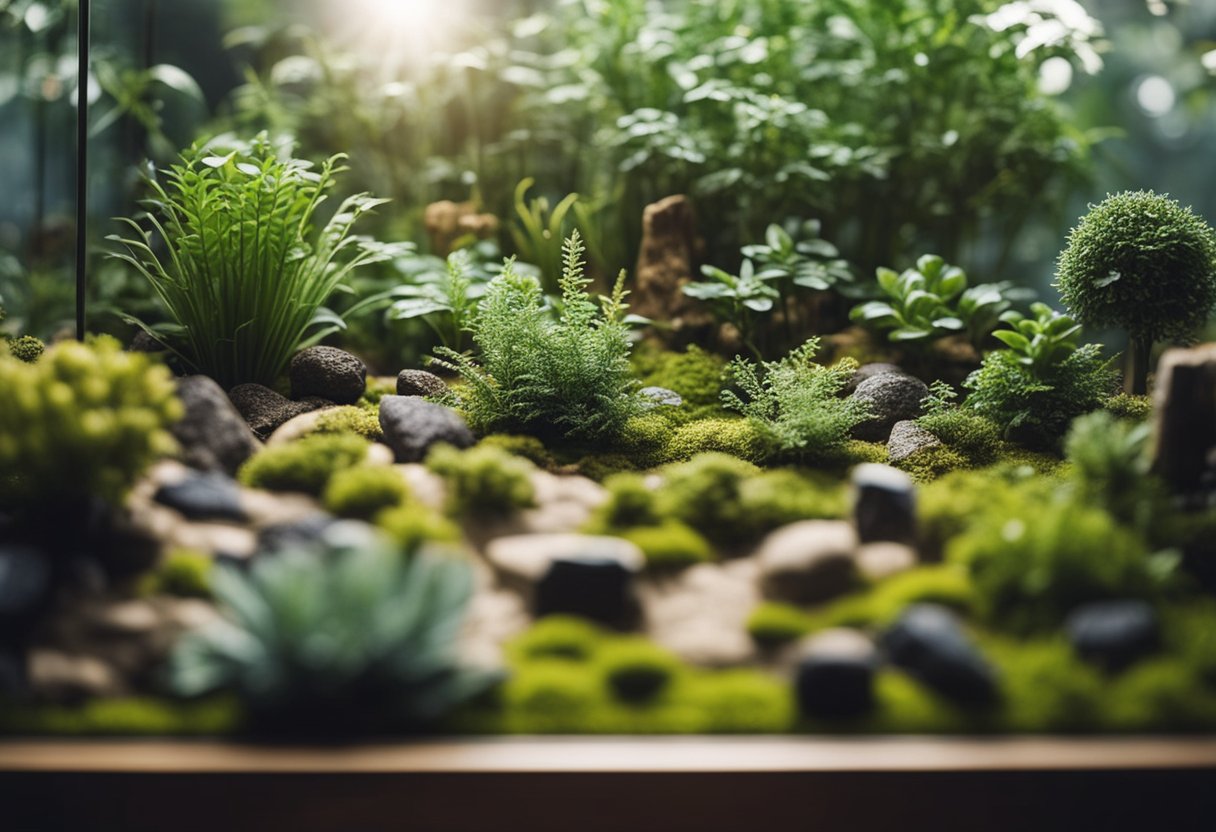
Understanding Terrariums can be a fun and rewarding experience. Not only do they add a touch of nature to your space, but they can also help improve air quality and reduce stress. There are many different types of terrariums to choose from, including open and closed designs, desert and tropical themes, and even aquatic options. Once you’ve selected the type of terrarium you want to create, you can choose your container, plants, and other components to bring your vision to life.
Key Takeaways:
- Terrariums are a low-maintenance way to bring greenery into your home or office.
- There are many different types of terrariums to choose from, including open and closed designs, desert and tropical themes, and even aquatic options.
- Once you’ve selected the type of terrarium you want to create, you can choose your container, plants, and other components to bring your vision to life.
Understanding Terrariums
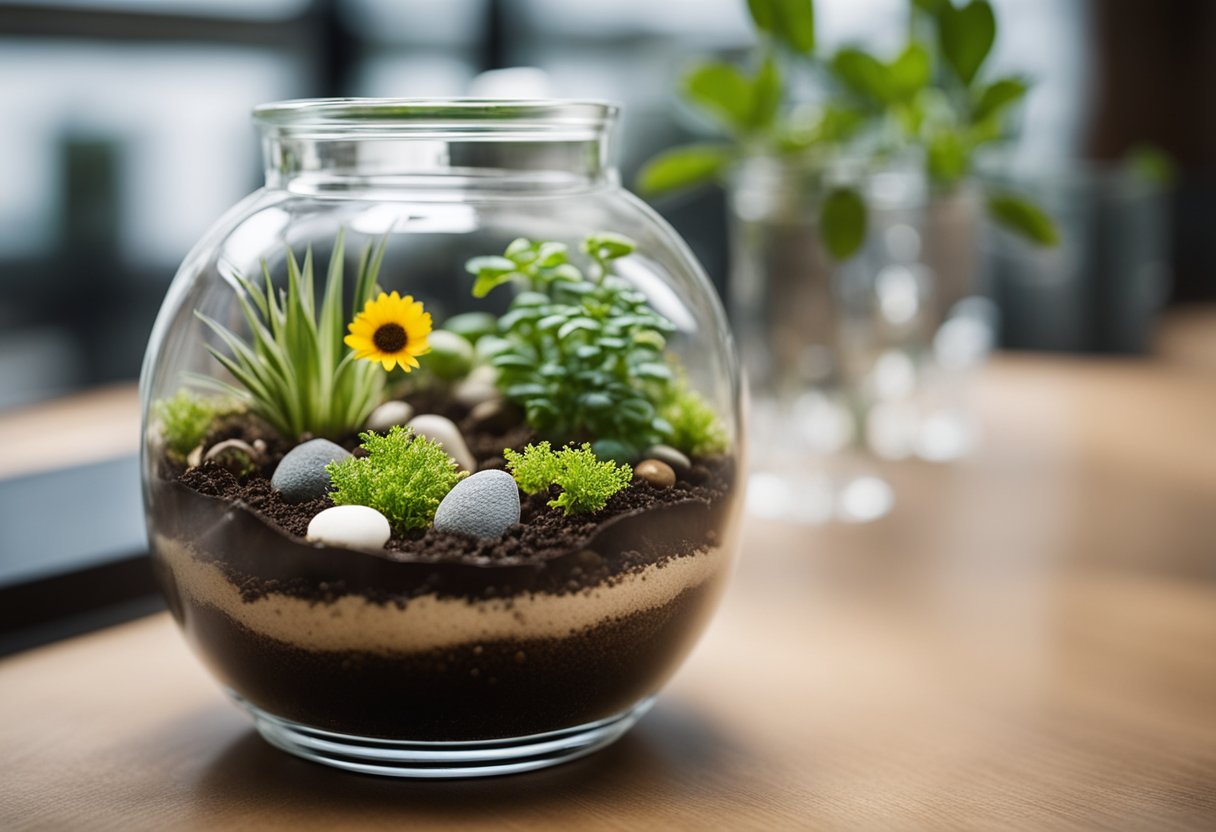
You may have heard of terrariums before, but do you really understand what they are? Terrariums are miniature gardens that are housed inside small glass containers. These containers can be open or closed, and they can be designed to be self-sustaining ecosystems.
There are two main types of terrariums: open and closed. Open terrariums are designed to allow air to flow freely through the container. Closed terrariums, on the other hand, are sealed to create a self-sustaining ecosystem. Closed terrariums are often used to house tropical plants, as they can create a humid environment that is perfect for these types of plants.
Both open and closed terrariums can be designed to be self-sustaining. This means that the plants inside the container can water themselves through transpiration and condensation. In a self-sustaining terrarium, you won’t need to water the plants very often, as they will take care of themselves.
There are many different types of terrariums that you can create. Some popular options include desert terrariums, rainforest terrariums, and even fairy gardens. Each type of terrarium requires different types of plants and soil, so it’s important to do your research before you start building your own.
In summary, terrariums are miniature gardens that can be housed inside small glass containers. They can be open or closed, and they can be designed to be self-sustaining ecosystems. There are many different types of terrariums that you can create, each with their own unique set of requirements. With a little bit of research and some creativity, you can create your own beautiful and unique terrarium.
Choosing Your Terrarium
Creating a terrarium is a fun and rewarding experience, but choosing the right container is crucial. Whether you want to go the DIY route or purchase a pre-made kit, there are many different types of containers to choose from.
One popular option is a glass container, which offers a clear view of your plants and allows for easy customization. You can find glass containers in all shapes and sizes, from classic pots to geometric terrariums and even egg-shaped designs.
If you’re feeling crafty, you can also create your own terrarium container using materials like mason jars, fish tanks, or even light bulbs. DIY terrariums are a great way to personalize your creation and make it truly unique.
When selecting a container, consider the size and shape of your plants. Some plants, like succulents, require less soil and can thrive in smaller containers. Others, like ferns, need more space to grow and may do better in larger pots.
If you’re not sure where to start, consider purchasing a pre-made terrarium kit. These kits come with everything you need to create your own mini garden, including a container, soil, and plants. They’re a great option for beginners or those who want a hassle-free experience.
No matter what type of container you choose, make sure it has proper drainage to prevent water from accumulating and causing root rot. You can also add decorative elements like rocks, sand, or figurines to enhance the overall look of your terrarium.
In summary, choosing the right container for your terrarium is an important step in the process. Whether you opt for a pre-made kit or create your own DIY design, consider the size and shape of your plants, ensure proper drainage, and have fun with decorative elements.
Selecting Plants for Terrariums
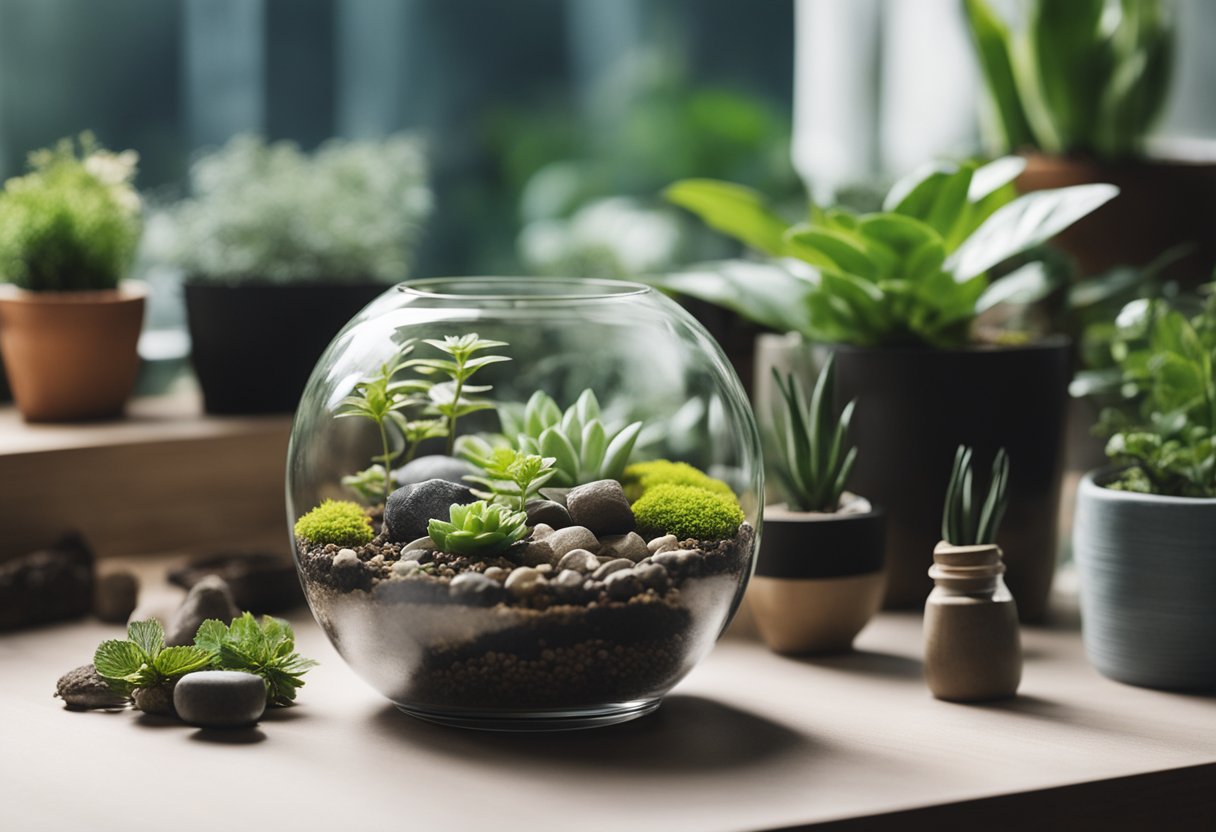
Creating a terrarium is a fun and exciting way to bring a little bit of nature into your home or office. When selecting plants for your terrarium, there are a few things to keep in mind to ensure that your plants thrive in their new environment.
First, consider the size of your terrarium. If you have a small terrarium, you will want to choose plants that stay small and don’t require a lot of space. Succulents and cacti are great options for small terrariums as they don’t need a lot of water and can tolerate dry conditions.
For larger terrariums, you can choose from a wider variety of plants, including ferns, mosses, and exotic plants. Ferns are a popular choice for terrariums as they add a lush, green look and thrive in humid environments. Mosses are also a great choice for terrariums as they don’t require a lot of light and add a soft, velvety texture to your terrarium.
Another consideration when selecting plants for your terrarium is the amount of light your terrarium receives. If your terrarium is in a location that doesn’t receive a lot of natural light, you will want to choose plants that can tolerate low light conditions. Fittonia, also known as the nerve plant, is a great option for low light terrariums as it thrives in shady conditions.
If your terrarium is in a location that receives a lot of natural light, you can choose from a wider variety of plants, including air plants and desert plants. Green banana and peperomia are also great options for terrariums that receive a lot of light as they can tolerate bright, indirect light.
Overall, when selecting plants for your terrarium, it’s important to choose plants that will thrive in the environment you provide. Consider the size of your terrarium, the amount of light it receives, and the humidity levels to ensure that your plants stay healthy and happy.
Creating Your Own Terrarium
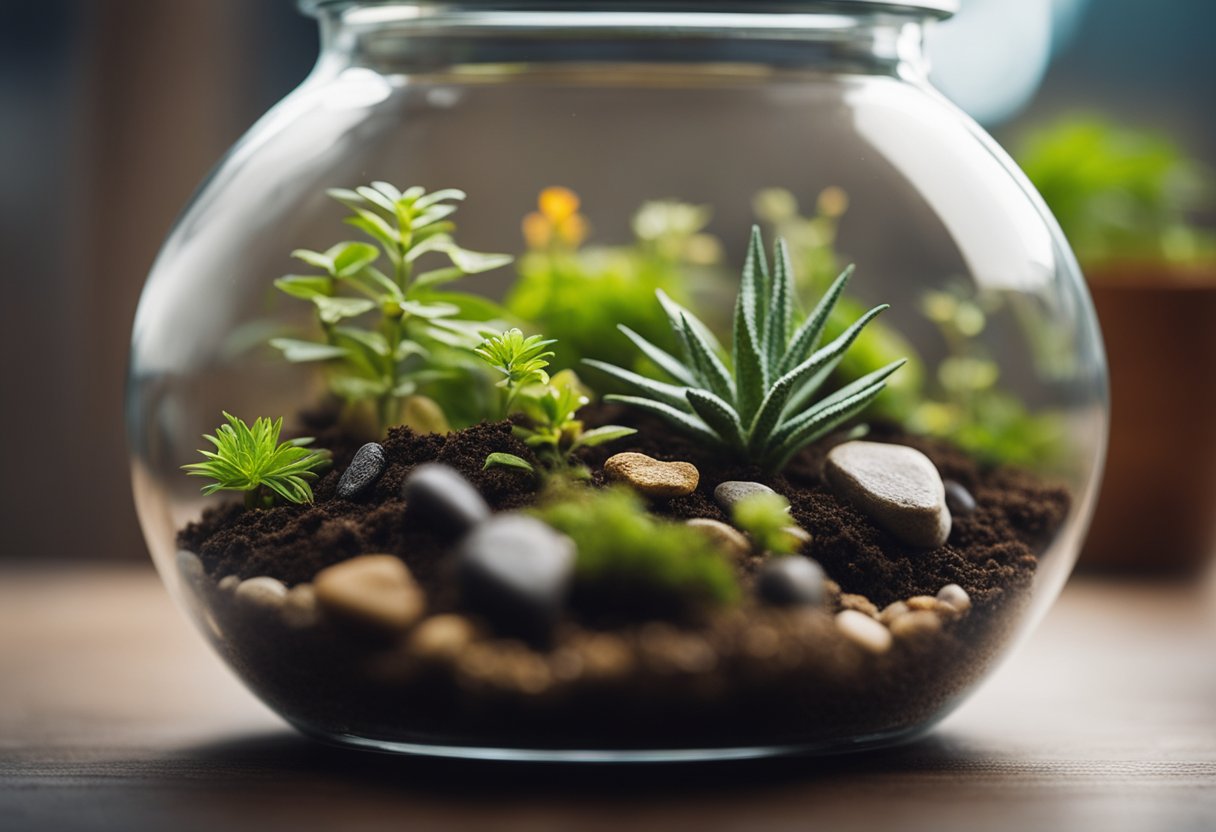
Are you ready to create your own miniature indoor garden? Making a terrarium is a fun and easy way to bring some green into your home or office. Here’s how to get started:
Step 1: Choose a Container
The first step in creating a terrarium is to choose a container. You can use just about anything that is clear and has a lid, such as a glass jar, fishbowl, or even a light bulb. Make sure the container is clean and dry before you begin.
Step 2: Add Drainage Material
To prevent your plants from getting waterlogged, you’ll need to add a layer of drainage material to the bottom of your container. This can be anything from gravel to pebbles to activated charcoal. Just make sure it covers the bottom of the container evenly.
Step 3: Choose Plants
Selecting the right plants for your terrarium is important. You’ll want to choose plants that are small enough to fit in the container and that have similar light and water requirements. Succulents and cacti are great options for terrariums, as they require little water and can thrive in a closed environment.
Step 4: Add Soil
Once you’ve chosen your plants, it’s time to add soil. Use a high-quality potting soil that is appropriate for the types of plants you’ve chosen. Add enough soil to cover the roots of your plants.
Step 5: Pick Decorations
Adding decorations to your terrarium can make it even more beautiful and interesting. You can use anything from small figurines to rocks to seashells. Just make sure they are small enough to fit in the container.
Step 6: Arrange Your Plants
Now it’s time to arrange your plants in the container. Place them in the soil and make sure they are spaced evenly. You can use a pair of tweezers to help you position them if necessary.
Step 7: Water Your Plants
After you’ve arranged your plants, it’s time to water them. Use a spray bottle to mist the soil and plants lightly. Be careful not to overwater, as this can cause your plants to rot.
Step 8: Provide Light and Heat
Place your terrarium in a location where it will receive plenty of indirect sunlight. Avoid placing it in direct sunlight, as this can cause the temperature inside the container to rise too high. You can also add a small lamp or heat mat to provide additional warmth if necessary.
Step 9: Monitor Your Terrarium
Keep an eye on your terrarium and make sure it stays healthy. If you notice any signs of mold or rot, remove the affected plants immediately. You may also need to adjust the amount of water or light your terrarium receives.
Step 10: Enjoy Your Creation
Congratulations, you’ve created your own terrarium! Sit back and enjoy your miniature garden. Terrariums are a great way to add some green to your home or office, and they also make great gifts. If you’re interested in learning more about terrariums, consider attending a terrarium workshop or checking out some books on indoor gardening and crafts for green thumbs.
Remember, creating a terrarium is all about having fun and being creative. So don’t be afraid to experiment with different plants and decorations to make your terrarium truly unique. Happy gardening!
Terrarium Care and Maintenance
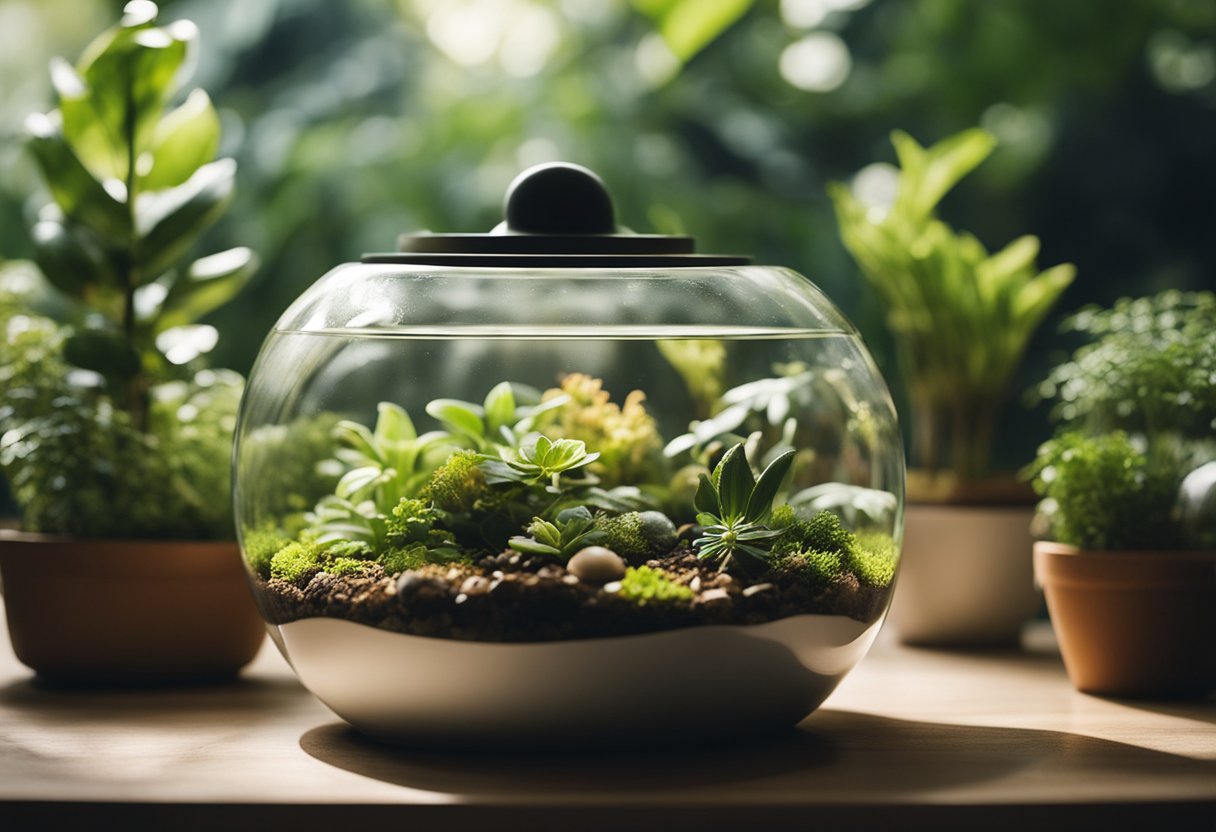
Congratulations on your new terrarium! Taking care of a terrarium is not as difficult as you might think. With a little bit of effort, you can enjoy a beautiful and thriving mini ecosystem in your home or office. Here are some tips to help you care for your terrarium:
Watering
One of the most important aspects of terrarium care is watering. Overwatering can lead to root rot and other issues, while underwatering can cause the plants to dry out and die. The key is to find the right balance.
Check your terrarium regularly and water it only when the soil is dry to the touch. Use a watering can or spray bottle to water the plants gently. Be careful not to overwater, as excess water can lead to mold and other problems.
Maintenance
Terrariums require minimal maintenance, but it’s important to keep an eye on them. Remove any dead leaves or plants as soon as you notice them. Trim back any overgrown plants to prevent them from taking over the terrarium.
Humidity and Moisture
Terrariums thrive in high humidity environments. However, too much moisture can lead to mold and other issues. Keep an eye on the terrarium for any signs of condensation. If you notice excess moisture, remove the lid for a few hours to allow the terrarium to dry out.
Direct Sunlight
Terrariums should be placed in indirect sunlight. Avoid placing them in direct sunlight, as this can cause the plants to burn and dry out.
Excess Water
If you accidentally overwater your terrarium, don’t panic. Use a paper towel or cloth to soak up any excess water. You can also remove the lid for a few hours to allow the terrarium to dry out.
With these tips, you can keep your terrarium healthy and thriving. Enjoy the beauty of your mini ecosystem and watch as it grows and evolves over time!
Components of a Terrarium
Creating a terrarium can be a fun and rewarding experience. To ensure that your terrarium thrives, it’s important to understand the various components that make up a successful terrarium ecosystem. Here are the key components you’ll need to consider when building your terrarium:
Container
First and foremost, you’ll need a container to house your terrarium. There are a variety of containers to choose from, including repurposed glass jars, fish tanks, and specially designed terrarium containers. When selecting a container, consider the size and shape of the container, as well as the type of plants you plan to use.
Gravel or Pebbles
A layer of gravel or pebbles at the bottom of your terrarium serves as a drainage layer, allowing excess water to drain away from the soil and plant roots. This helps prevent water from pooling and causing root rot. Choose a layer of gravel or pebbles that is about 1-2 inches deep.
Charcoal or Activated Charcoal
Adding a layer of charcoal or activated charcoal on top of the gravel helps keep your terrarium fresh by absorbing odors and impurities. This is especially important if your terrarium is closed or has a lid. A layer of charcoal or activated charcoal that is about 1/2 inch deep is sufficient.
Sand
A layer of sand can be added on top of the charcoal layer to help with drainage and to create a natural-looking base for your terrarium. Choose a layer of sand that is about 1/2 inch deep.
Soil
The soil layer is where your plants will grow, so it’s important to choose a high-quality soil that is appropriate for the types of plants you plan to use. Choose a soil layer that is about 2-3 inches deep.
Plants
Choose plants that are well-suited for the environment you’ve created in your terrarium. Consider factors such as light, humidity, and temperature when selecting plants. It’s also important to choose plants that are small enough to fit comfortably in your container.
Decorative Elements
Adding decorative elements to your terrarium can help create a unique and visually appealing display. Consider adding rocks, moss, or other natural elements to enhance the overall aesthetic of your terrarium.
By carefully selecting and layering the various components of your terrarium, you can create a thriving ecosystem that brings a touch of nature into your home or office.
Decorating Your Terrarium
Now that you’ve created your own beautiful terrarium, it’s time to decorate it to make it truly unique and personalized. Here are some tips to help you get started:
1. Choose the Right Decor
When it comes to decorating your terrarium, the possibilities are endless. You can add natural elements like rocks, branches, or moss to create a more outdoorsy feel. Alternatively, you can go for a more minimalist look with simple decor like sand or colored stones. Whatever you choose, make sure it complements the plants in your terrarium and the overall aesthetic you’re going for.
2. Add Figurines
Adding figurines is a great way to inject some personality and charm into your terrarium. You can choose from a variety of options like animals, fairies, or gnomes to create a magical setting for your miniature garden. Make sure to choose figurines that are appropriately sized for your terrarium and don’t overcrowd the space.
3. Include Lights
Adding lights to your terrarium can create a beautiful and enchanting effect. You can use fairy lights or LED lights to highlight specific areas or create a warm, cozy ambiance. Make sure to choose lights that are safe for indoor use and won’t damage your plants.
4. Consider the Frame
The frame of your terrarium can also be a great way to add some visual interest. You can choose from a variety of materials like wood, metal, or glass to create a unique look. Make sure to choose a frame that complements the decor and plants in your terrarium.
5. Use a Glass Dome
Using a glass dome can create a beautiful and elegant display for your terrarium. It can also help regulate the humidity and temperature inside the terrarium, which is important for the health of your plants. Make sure to choose a dome that fits your terrarium and complements the overall aesthetic.
6. Keep it Simple
Remember, sometimes less is more when it comes to decorating your terrarium. A simple, minimalist look can be just as beautiful as a more elaborate display. Experiment with different decor and figurines to find the perfect balance for your terrarium and home decor.
7. Add Flowers
Adding flowers to your terrarium can create a beautiful and colorful display. Choose flowers that are appropriate for the environment inside your terrarium and complement the other plants and decor. Make sure to research the specific care requirements for each type of flower to ensure they thrive in your terrarium.
With these tips, you can create a truly unique and personalized terrarium that will be the envy of all your friends. Have fun experimenting with different decor, figurines, and lighting options to find the perfect look for your home decor.
Terrariums Around the World
If you’re looking for a unique and exciting way to bring nature into your home, then look no further than terrariums. These miniature ecosystems have been gaining popularity all around the world, and it’s not hard to see why. From Singapore to the United States, there are countless variations of these beautiful creations that are sure to captivate your imagination.
One of the most popular places to find terrariums is in Singapore, where they have become a staple of home decor. Lush Glass Door is one of the most well-known shops in the city, offering a wide variety of terrariums in all shapes and sizes. The Green Capsule is another great option, with a focus on sustainability and eco-friendliness. They even offer workshops where you can learn how to make your own terrariums!
If you’re looking for something a little more unique, then check out Terrarium4u in Thailand. They specialize in creating terrariums that are inspired by popular movies and TV shows, such as Star Wars and Game of Thrones. Each terrarium is a work of art, and they make for great conversation starters.
Inout Atelier in Spain is another great option if you’re looking for something truly special. They create one-of-a-kind terrariums that are made from recycled materials, such as old light bulbs and glass jars. These terrariums are not only beautiful, but they’re also environmentally friendly.
Finally, if you’re in the United States, then be sure to check out your local garden center. Many of these stores now offer terrariums, and they often have a wide variety of plants and containers to choose from. Whether you’re looking for something small and simple, or large and elaborate, you’re sure to find something that suits your needs.
No matter where you are in the world, there’s a terrarium waiting for you. So why not bring a little bit of nature into your home today?
Commercial Terrariums
If you are looking to add a touch of nature to your commercial space, a terrarium is a great way to do so. Terrariums are low maintenance, visually appealing, and can be customized to fit any space.
One of the benefits of commercial terrariums is that they can be affordable. You don’t need to spend a lot of money to create a beautiful terrarium. With the right supplies and some creativity, you can design a stunning terrarium that fits your budget.
If you need to create multiple terrariums for your commercial space, buying in bulk can be a cost-effective option. Many suppliers offer discounts on bulk orders, making it easier to purchase the supplies you need without breaking the bank.
Consultation is also available for those who want to ensure that their commercial terrariums are designed and installed correctly. J2 Terrarium is one of the companies in Singapore that provides consultation services. They can help you choose the right plants, containers, and accessories for your space, as well as provide guidance on maintenance.
When it comes to commercial terrariums, the possibilities are endless. You can create a terrarium that fits your brand and aesthetic, and adds a unique touch to your space. With the right supplies and a little creativity, you can create a beautiful and low-maintenance terrarium that will impress your customers and clients.
Unusual Terrarium Inhabitants
Are you tired of the same old terrarium inhabitants? Want to add a little excitement to your miniature ecosystem? Look no further than these unusual terrarium inhabitants.
Isopods
Isopods, also known as pill bugs or roly-polies, are small crustaceans that make great terrarium inhabitants. They help keep the soil clean by eating dead plant matter and other debris. Plus, they’re just plain cute to watch as they scurry around.
Ficus Pumila
Ficus Pumila, also known as creeping fig, is a popular terrarium plant. Its small leaves and vine-like growth make it perfect for creating natural landscapes in your terrarium. Plus, it’s easy to care for and can thrive in a variety of lighting conditions.
Birds
Yes, you read that right. Birds can make great terrarium inhabitants, especially if you have a large enough terrarium. Small finches or canaries can add a unique touch to your miniature ecosystem. Just make sure to provide plenty of perches and hiding spots for them.
Air Plants
Air plants, also known as Tillandsia, are unique terrarium inhabitants that require no soil to grow. They absorb nutrients and moisture from the air, making them a low-maintenance option for your terrarium. Plus, their unique shapes and colors can add a pop of interest to your terrarium design.
Natural Landscapes
Why settle for a plain old terrarium when you can create a natural landscape? Use rocks, moss, and other natural elements to create a miniature version of your favorite outdoor environment. Whether it’s a desert or a rainforest, the possibilities are endless.
Vines
Vines are a great way to add height and dimension to your terrarium. Whether you choose a classic ivy or a more unique variety like the string of hearts plant, vines can add a touch of whimsy to your miniature ecosystem.
So, if you’re looking to add a little excitement to your terrarium, consider these unusual inhabitants. From isopods to birds, there’s something for everyone.
The Science Behind Terrariums
If you’re a fan of greenery but lack a green thumb, then terrariums are the perfect solution for you. These miniature gardens enclosed in a bottle are not only aesthetically pleasing but also self-nourishing. But have you ever wondered about the science behind terrariums? Let’s explore!
Firstly, terrariums are a simplified version of major ecosystems on our planet, such as rainforests and deserts. They are self-contained and rely on the right balance of nutrients, water, and sunlight to thrive. The plants inside a terrarium release oxygen through photosynthesis and absorb carbon dioxide. In turn, the soil in the terrarium provides the plants with nutrients such as nitrogen, phosphorus, and potassium.
The Latin name for a terrarium is “terra,” which means earth. And the earth inside a terrarium is a living, breathing ecosystem. The greenery inside the terrarium is not just for show, but it also helps to purify the air. Plants absorb toxins and pollutants, making the air inside your home cleaner and healthier.
Maintaining a terrarium requires a little bit of science and a lot of love. You need to make sure the plants have the right amount of light, water, and nutrients. Too much or too little of any of these can affect the health of the plants. But don’t worry, with a little bit of research and practice, you’ll become a terrarium expert in no time.
Lastly, did you know that terrariums can also be aquatic? An aquarium terrarium is a self-sustaining ecosystem that includes aquatic plants and animals. The science behind an aquarium terrarium is similar to that of a land-based terrarium, but with a focus on aquatic life.
In conclusion, the science behind terrariums is fascinating, and there’s a lot to learn about these miniature ecosystems. With a little bit of knowledge and effort, you can create a beautiful and self-sustaining garden in a bottle.
Frequently Asked Questions
What are some easy plants to use in a terrarium?
If you’re a beginner, it’s best to choose plants that are easy to care for. Some easy plants to use in a terrarium include succulents like echeveria and haworthia, ferns like maidenhair and bird’s nest ferns, and mosses like cushion moss and sheet moss. These plants are low maintenance and can thrive in the enclosed environment of a terrarium.
Where can I find terrarium supplies?
You can find terrarium supplies at your local garden center or online. Some popular online retailers for terrarium supplies include Amazon, Etsy, and Terrariums.com. You can also find a wide selection of supplies at specialty terrarium shops.
How do I make a large terrarium?
Making a large terrarium is similar to making a small one, but you’ll need to choose larger plants and a bigger container. Start by choosing a container that is at least 12 inches in diameter and 18 inches tall. Next, add a layer of gravel or pebbles to the bottom of the container, followed by a layer of activated charcoal. Then, add a layer of potting soil and arrange your plants in the soil. Finish by adding decorative elements like rocks or figurines.
What are the benefits of using glass for a terrarium?
Glass is a popular material for terrariums because it allows for maximum light transmission. This is important for plants, as they need light to photosynthesize and grow. Glass is also easy to clean and provides a clear view of the plants inside the terrarium.
What’s the difference between a closed and open terrarium?
Closed terrariums are sealed environments that create a humid atmosphere for plants. They require less maintenance and are ideal for plants that thrive in moist conditions. Open terrariums, on the other hand, are not sealed and are subject to the outside air. They require more maintenance and are better suited for plants that prefer drier conditions.
How do I care for a succulent terrarium?
Succulent terrariums require minimal watering and should be placed in a sunny location. Water your succulent terrarium only when the soil is completely dry. Overwatering can cause the plants to rot. Additionally, make sure the container has good drainage to prevent water from pooling at the bottom.




